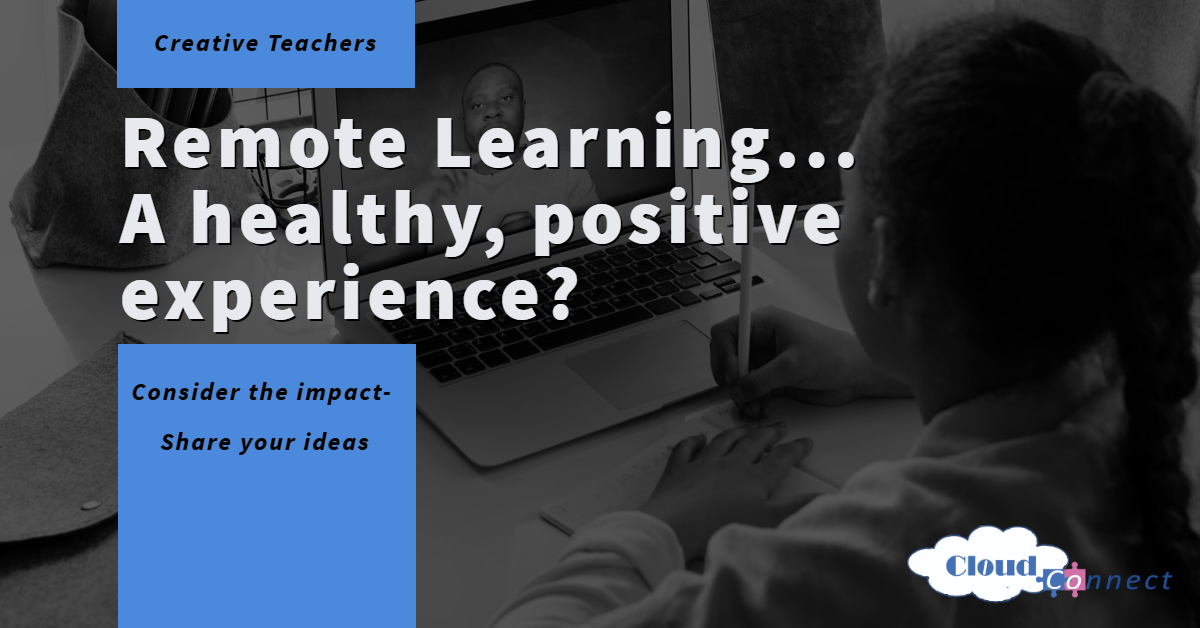Teachers…consider a range of virtual lesson experiences to minimize negative health impacts.
How do we ensure Remote Learning is a positive and healthy experience?

As we move into another National Lockdown and schools are ordered to close to most students, the issue of remote learning provision is raised once again.
There are of course dangers associated with online activity and there is a wealth of guidance around keeping safe, reporting concerns and maintaining confidentiality during virtual lessons. However, have we properly explored the health and wellbeing dangers?
The government has advised schools that they should deliver at least 3-5 hours of virtual lessons per day. This amounts to a possible 25hrs of focused screen time per week. Many schools will aim to deliver a full timetable of lessons in a virtual medium; which could be up to 8 hours a day for some students with additional support or extension classes.
Last year, I worked with a large academy in London dedicated to providing this full timetable of lessons, to as many students as possible. Staff worked incredibly hard to deliver this and the school provided laptops and dongles to help families with limited resources. Their pastoral team monitored attendance and were in regular contact with families to try to support learning and wellbeing. My role was to contact students who had not attended all of their lessons, to see if they needed any support to access them, and to motivate those who were finding it difficult to keep up.
 I quickly found, within 2 weeks that many of these phone calls checking on attendance, uncovered serious health problems associated with the constant screen time. Children reported headaches, migraines, eyesight problems, dizziness and sickness. Having been a teacher for 20 years and a parent for 10 (not to mention a student for many years some time ago), I am not naive. I know that not all children have a constant love for learning and if there is an excuse to be found many will use it. This was a unique situation, never before experienced and many would have been delighted not to be allowed to attend school. However, these health concerns are supported by medical evidence.
I quickly found, within 2 weeks that many of these phone calls checking on attendance, uncovered serious health problems associated with the constant screen time. Children reported headaches, migraines, eyesight problems, dizziness and sickness. Having been a teacher for 20 years and a parent for 10 (not to mention a student for many years some time ago), I am not naive. I know that not all children have a constant love for learning and if there is an excuse to be found many will use it. This was a unique situation, never before experienced and many would have been delighted not to be allowed to attend school. However, these health concerns are supported by medical evidence.
The association of Optometrists explain that using ‘near vision’ – whether that be reading or screen time can cause eye strain. Digital eye strain relates to screen time.
“One of the main symptoms is temporary blurred vision but other signs such as sore and tired eyes, dry eye and headaches are also associated with digital eye strain.” (https://www.aop.org.uk/advice-and-support/for-patients/childrens-eye-health/screen-time-for-kids-facts-for-parents)
They state that this does not cause permanent damage – but that is due to a lack of evidence. There is, however, some evidence developing of a possible link between extended screen time and short-sightedness (myopia).
It is also reported that we blink less when watching a screen, which affects the protective film over our eyes, and can lead to related problems including greater risk of damage and infection.
Blue light is increasingly linked to poor sleep patterns and reduced levels of concentration.
As parents we are encouraged to limit screen time. This is due to the concerns raised above and also the likelihood that this time will be more sedentary – leading to a vast array of health implications.

Tips for keeping your child’s eyes healthy:
1. Get them outdoors – regular play and exercise can help prevent or reduce the development of myopia (short-sightedness). Studies show two hours of outdoor activity a day is ideal1
2. Use night settings - using night settings, if your device has them, may help children sleep by reducing the amount of blue light given off by the screen during night-time hours
3. Make sure digital devices are turned off at least an hour before bedtime
4. Book your child in for a sight test every two years, from the age of three, or more often if your optometrist recommends it
(https://www.aop.org.uk/advice-and-support/for-patients/childrens-eye-health/screen-time-for-kids-facts-for-parents)
As a teacher I am also acutely aware of the different learning styles students have, some of which are very hard to address in a virtual lesson – many of the students I spoke to said that they found it hard to keep up and to access the learning in this way. Many felt increased peer pressure and that they were much more visible in a virtual lesson. Some stated that they had chosen not to attend PE or ART lessons but to do relevant activities during this time instead. (Again – not naïve – but a valid point none-the-less).
What can we do?
The advice from many medical sources agree – children need to be active, activities need to be varied, breaks need to be built in and we should monitor health, eye-sight and behaviour.
Shockingly, the Government guidelines for good practice in remote education (with advice from the Education Endowment Foundation) do not make suggestions related to taking breaks and using physical activities within the learning experiences. They acknowledge practical subjects are more difficult to deliver and suggest:
“…video demonstrations (and there are many ready-to-use examples linked to the curriculum available on platforms such as YouTube) can substitute well for practical work, particularly if accompanied by teacher explanation, commentary and a textbook or electronic resource.” (https://www.gov.uk/government/publications/remote-education-good-practice)
I have ‘watched’ several fitness DVDs without getting fitter!
They suggest for PE “…pupils should be encouraged to take regular physical exercise to maintain fitness.” (https://www.gov.uk/government/publications/remote-education-good-practice)
I am all in favour of maintaining meaningful, quality education for our children and am immensely proud of those in my profession for all that they have achieved, with so little external support.
However, I would urge them (and many of course will naturally do this) to look for opportunities to:
• get the class away from the screen,
• set practical activities, include physical movement or mental rehearsal with eyes closed
• perhaps act out concepts or play short games to break up the session,
• ask students to explain a concept whilst doing a physical action – this also aids long term memory
• set family tasks for the weekend (not mandatory-some families cannot do this)
• make use of additional resources, such as those now offered free from TwinklGo! and Twinkl Home Learning Hub, BBC live lessons and BBC bitesize and BBC Bitesize Daily on BBC1 and BBC2, there are loads of free online Maths and English platforms with games and activities for all ages
• get students to plan activities/lessons themselves to keep them engaged
Share your ideas with us and we’ll pass them on!

Yes, technology may well have saved us in this most challenging situation in many ways – but let’s not lose our creativity, let’s not rely on it as a new toy that will solve all our problems. There is always another way and our teachers and students are some of our most creative assets. Teachers can only achieve this with support from Senior Leaders too – widen your expectations and take some pressure off the teachers – reduce observations and celebrate good healthy practice.